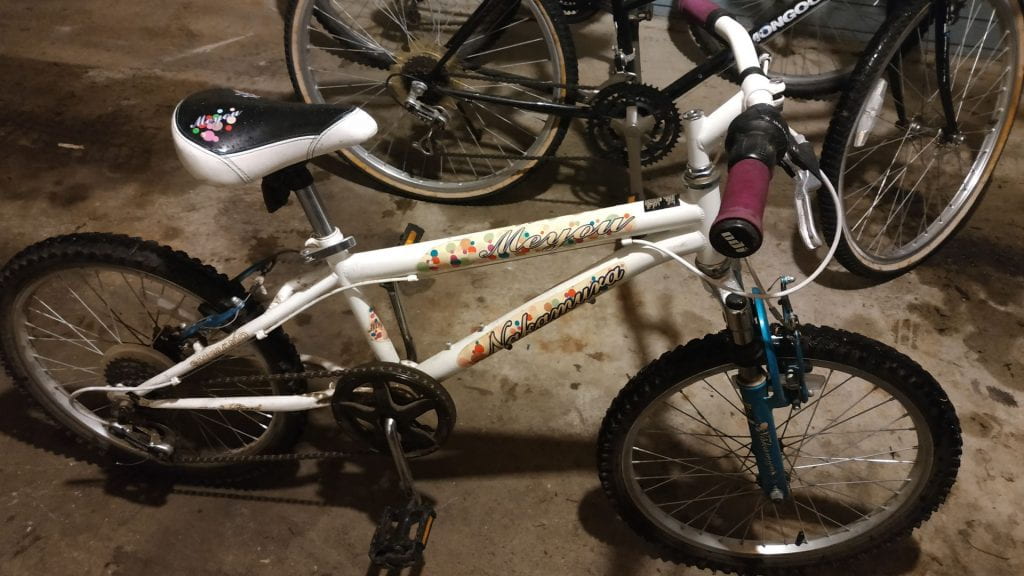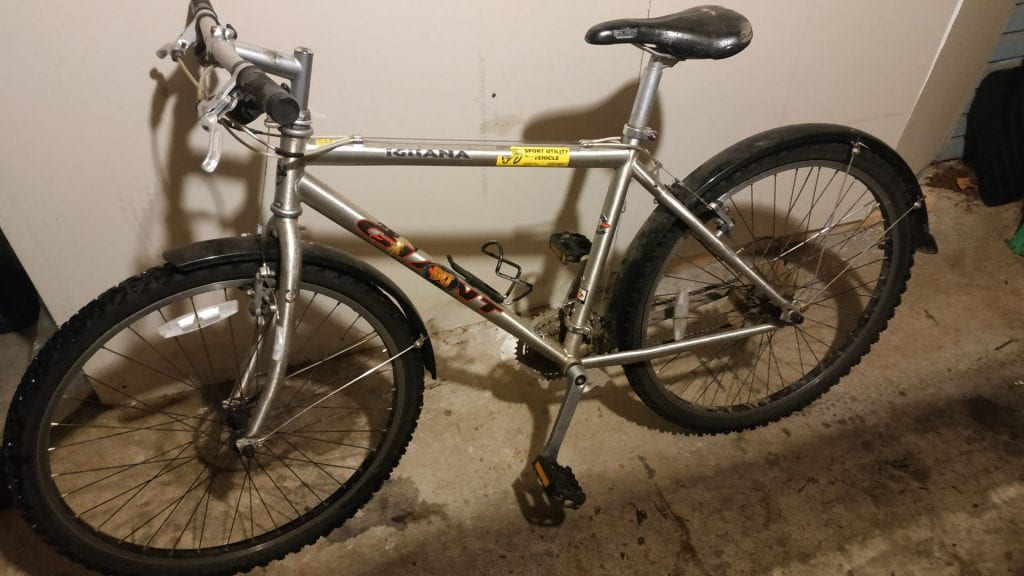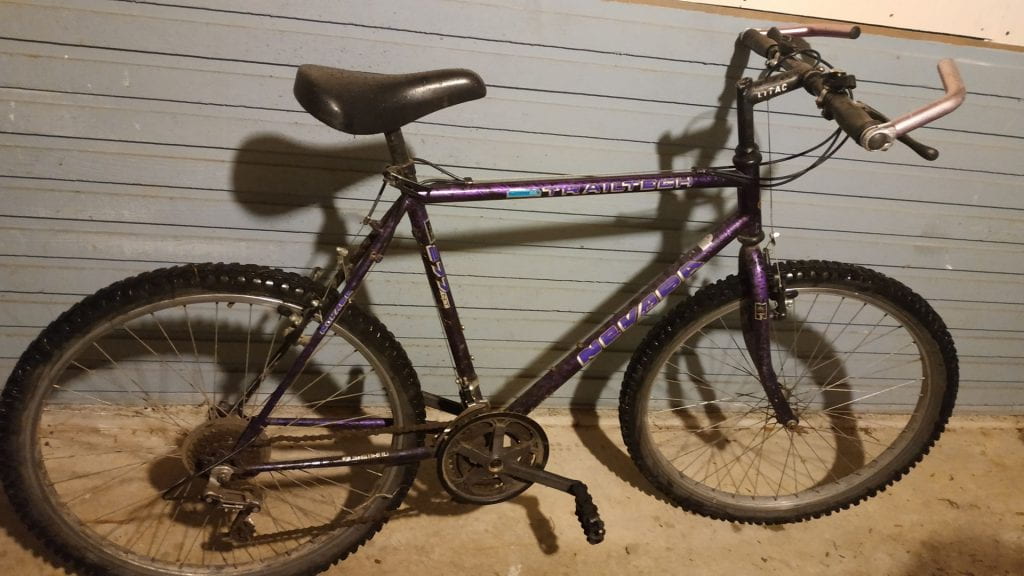Progress Report
I have had two more (the third and fourth) meetings with my mentor since I last posted. I have learned a great deal, including the two Sub-Skills of how to inspect a bike and how to fix a flat tire.
Details of each sub-skill that I learned:
Bike inspection:
I practiced bike inspection with a bike inspection checklist that my mentor provided me, identifying the details of what is working and what is not working on each of the five bikes I have. As a side note, each bike is identified by a name given by myself. I will list them here so that in the future when I speak of each, they will be identifiable to the reader. Please hover over each picture to see its name (NOTE: A photo for Bike #1: “Wiry Black Mongoose” is unavailable because WordPress will not let me upload any more images right now!!!):

Bike #2: “Little White Nakamura” (my little sister’s bike) 
Bike #3: “Glinting Silver Giant” 
Bike #4: “Tall Violet Nevada” 
Bike #5: “Faithful Blue Trek” (my bike!)
At the last meeting, David and I reviewed my inspections of two of the bikes, the silver Giant and my blue Trek, ensuring that I was properly inspecting each bike.
How to fix a flat tire:
This was a brand-new sub-skill that I learned with my mentor at our last (fourth) meeting. Please see the attached videos titled “Learning to fix a flat tire,” Parts 1 and 2, to get a glimpse into this experience.
To elaborate, laying my hands on a bicycle tube was something I had never done before. Additionally, one of the main foundational concepts I learned from this is the anatomy of a bike wheel. First, there is the hub of the wheel, which spins because it has ball bearings on an axle within the hub. Then, there are the spokes (which can be trued, and also at our last meeting, my mentor and I touched on truing wheels; he demonstrated and explained a little bit of the sub-skill on my bike and I was able to connect the information with my existing knowledge from trying to true wheels on my own during the summer) that connect to the wheel rim. Attached to the rim is the tire, and within the tire is the bicycle tube and valve. Admittedly, the part about there being a bicycle tube inside the tire was rather new information for me, but now I have gained that knowledge with hands-on experience—please take a look at the linked videos.
Tasks I undertook that did not work out:
These ‘issues’ do not impede the functionality of the bike:
I tried lubricating one of the pedals on my bike that was not spinning as freely as the other one:
I also tried fixing the twisting hand grips on my bike.
Next steps:
My mentor and I are planning to have our next meeting about a week from now, on Sunday the 13th. Between now and then, I am planning to act on our fourth meeting action items. For example, I would like to practice fixing a flat tire on one of the bikes, so a recording of myself doing that on my own will be present in the next post. To continue making progress on checking off sub-skills, I will also be dabbling a little on my own with adjusting/repairing brakes before learning how to properly do so on cantilever brakes at my next mentor meeting. As such, I will have recordings of myself performing this sub-skill on both V-brakes and Cantilever brakes in the next post. I will also read some books/do some research on maintaining the chain/drivetrain this weekend. As for modifications to my project, I might need to be a little flexible around my deadline of learning four sub-skills (March 6th).
Mentor
My mentor and I have had four meetings by now, each being one to three hours long, and we have talked about lots of different subjects regarding bike maintenance during these get-togethers. David has given me a lot of knowledge, tips, and guidance that I never would have acquired on my own and I am looking forward to continuing this journey/project.
Obstacles/Frustration
A minor frustration I have had since the last post is how neither of the tasks I undertook of trying to fix the handgrip or the pedal worked out. However, I troubleshot with my mentor and what I have learned from this is that some bike parts are just made not to be serviced—they are made to be replaced—like the pedal. Also, I can gain the insight that I need to troubleshoot and find out why when what I do does not work. In the case of the handgrip, I need to remove all the WD-40 before spraying on the alcohol (will do soon), otherwise, the alcohol will not be able to grip the handgrip.
Perhaps another frustration is that the light my dad installed for me in the garage turns out not to be compatible, using too much of our garage’s electricity, so I will need to find another way to get good lighting while I work. I will try using several portable lamps/lights and if that does not work, my work time will need to be restricted to light hours of the day, which may be another obstacle because I am already limited in my time.
Posted Questions
What went particularly well during your mentoring sessions?
I would say that both my mentor and I showed great active listening during our mentoring sessions. We would both listen attentively to each other, affirm understanding with statements such as “Got it” or “I see,” and we would also paraphrase or ask follow-up questions to further or confirm understanding. Additionally, being able to record my learning of how to fix a flat tire was particularly good, or should I say that the coaching approach and hands-on learning of it went particularly well. To cap it off, my mentor provided me with amazing explanations to my questions and so that is something else that went particularly well.
What three strategies could improve the quality of your mentoring interactions?
To improve the quality of my mentoring interactions, I would like to show more nonverbal cues to encourage my mentor to share his expertise and engage in the conversation even more, especially with the face masks. Secondly, I think showing more gratitude to my mentor for everything he is doing for me will also improve the quality of my mentoring interactions, as that is how I can give back. The final strategy is to deliver results to show David so that he may be rewarded with my success.
What is the action plan for implementing each of the three strategies?
My action plan for showing my nonverbal cues during in-person sessions with David is that I will listen actively by smiling/listening with my eyes, nodding, and eye contact, whenever my mentor is explaining to me or telling me something. I have noted this, and I will be sure to implement this strategy at my next meeting. Next, to show my gratitude, I shall be sure to give genuine thanks to my mentor at the next meeting. I will try my best to make sure that David feels good about helping me out, that he can walk away from the next meetings glowing and feeling better off having spent time with me than if he hadn’t.